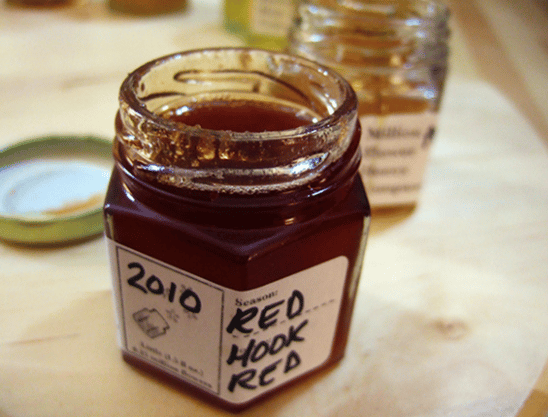The summer of 2010 in New York city was one of the hottest the city experienced in the last years. The natural landscape of the Big Apple (how it is friendly call by newyorkers) turned in an unsual uncolorful fall. The blossoms were dried, easily perished, the weeds present along the highway were loosing their natural strenght and sleeking on itselves like twisted wire. Meanwhile, in the middle of July a strange phenomena started to draw attention, some local beekeepers suddently started to see incandescent red bees flying the sky at sunset. It was like a bizarre apocalypse was unleashed.
What was intereting to note was that until a few months before to keep bees in New York City was considered illegal. However, it was known that a few beekeepers did not respected the ban and instead camouflaged their hives with faux-brick contact paper or made them blend in with the building rooftops. After the ban was lift in March, the urban hives started to spread and in a couple of months the number of hives in the area went from about three to more than a dozen. This huge increase in the bees population along with the unprecedented heat made water and nectar became harder to find.
Soon beekepers started to noticed that the honey was turning red. The members of the New York City’s beekeepers comunity started to speculate about ‘what was the reason behind this change of color’. The causes could be many, bees suffer colony-collapse disorders – which means the decimation of entire hives – morover, they have to deal daily with the presence of parasites, hornets, pesticides, deaseas, and not of less importance, the growing lack of flowers, forage and erratic weather. All factors that contribute at the drastic decline of the specie. This new and strange development was ideed a matter of concern.
First, the hypotesys was that the red honey could be the result of the bees might be bringing back spilled transmission fluid or antifreeze made of ethylene glycol, a substance that they could find in the depots of a nearby M.T.A buses. Since ethylene glycol is dangerous for people’s healt and can result fatal newyorkers’ beekeepers were advised to not eat the red honey until tests were run on it. After a while, a second option started to spread in the community. Bees were seen flying in the direction of the cherry factory Dell’s Maraschino Cherries, a family’s company led by Arthur Mondella (deceased in 2015), and located in the in the Red Hook section of Brooklyn. The bees have been by many visiting puddles of red juice around the factory. Tim O’Neal – who was a teacher of biology in middle school and at Brooklyn College and was closely following the events – took chunks of honeycomb from hives in and near the garden, put them in fifty-millilitre sample tubes, and in September mailed them to the state apiculturist for testing. Consequently, in October the mystery was finally solved! The honey result was positive for F.D.&C. Red No. 40, a food-safe dye, which was an ingredient of the maraschino syrup used by the Dell’s factory.
In conclusion, the honey was harmless but as reported by who had the chance to try it “The red honey tasted terrible […] It was sickly sweet, kind of metallic-tasting, and watery”. Nevertheless, after in November the story was disclosed and went all over the place and online a ton of red honey could be sold. Dozens of customers were asking for it. Even tough, all that red honey ended up being thrown.

